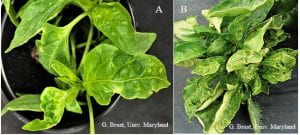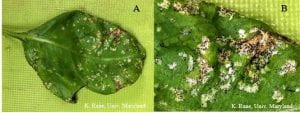Corn earworm moths counts in pheromone traps have been increasing over the past few days in some areas in Maryland and Delaware. Sweet corn growers should keep an eye out and consider shortening spray intervals to a 2 to 3-day spray schedule while others could still be around a 3 to 4-day spray schedule.
Category: Pest Update
Who has Been in My Strawberries? Slugs and Sap Beetles, Two Common Insect Pests on Strawberries.
By Sankara Ganesh, Maria Cramer, and Kelly Hamby.
Department of Entomology, University of Maryland, College Park
The cool, wet spring weather we have been experiencing favors slugs, so be on the lookout for slug damage. Slug damage may easily be confused for sap beetle feeding, but management of these pests is very different, so it is important to correctly identify the problem. Both pests can be common in matted row production.
Damage: Slug feeding renders fruit unmarketable and susceptible to infestation by other pests including sap beetles. Sap beetle adults are attracted to ripening, ripe, and overripe fruit and directly cause damage through feeding, but may also introduce pathogens and contaminate fruit with larvae. Sap beetles tend to leave behind circular holes while slug damage is often irregularly shaped, and both can cause moderate to deep holes. However, slugs will also feed on leaves and leave behind slime trails. Monitoring is important to conclusively determine which pest is causing damage.
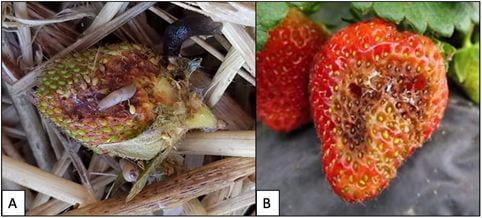

Still Time to Find and Remove Spotted Lanternfly Egg Masses
Doris Behnke, Senior Agriculture Agent Associate | dbehnke@umd.edu
University of Maryland Extension, Cecil County
The spotted lanternfly (Lycorma delicatula) is a invasive planthopper which is native to China, India, and Vietnam. It was detected in Pennsylvania in 2014, and has since been found to have confirmed populations in Delaware, Maryland, New Jersey, and Virginia. It has a broad host range including fruit, ornamental and woody plants.
Nymphs will begin hatching out in May so now is the time to remove the egg masses that the adult spotted lantern fly (SLF) laid last year. To do this you will need some hand sanitizer, a plastic bag, and a firm card for scraping.
- Squirt the hand sanitizer into the plastic bag.
- Arrange the opened bag just below the SLF egg mass.
- Apply a firm amount of pressure on the edge of the card and scrape the card down and across the egg mass.
- Catch the eggs in the bag, then squish the hand sanitizer and eggs around in the bag.
- Seal the bag and then dispose. Help stop the spread of SLF
For more information please visited the MDA website: https://mda.maryland.gov/plants-pests/Pages/spotted-lantern-fly.aspx
Allium (Onion) Leafminer
Allium leafminer (ALM), Phytomyza gymnostoma (Diptera: Agromyzidae), is an invasive leaf-mining fly from Poland that was first detected in Pennsylvania in 2015. They overwinter as pupae in plant tissue or surrounding soil. Adults emerge mid-March throughout April (250°Degree Days with a minimum temperature threshold of 3.5°C.). The adults are small (~ 3 mm) long grey or black flies with a distinctive yellow or orange area on the top and front of head and legs have distinctive yellow “knees” (Fig.1, Fig 2). The larvae are white maggots, headless, and around ~ 8 mm long at their final instar. The pupa are dark brown, ~3.5 mm long.
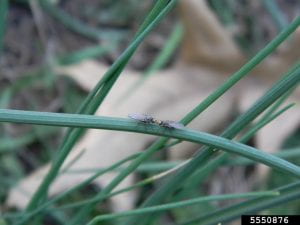
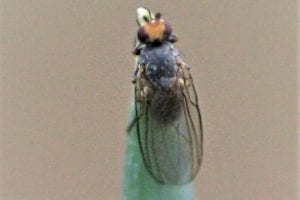
Adults will mate lay eggs inside the leaves of Allium species, creating a row of several small round white dots (made by the female’s ovipositor) on the top half of the leaf blades (Fig.3). Larvae mine leaves and move towards and into bulbs and leaf sheathes. Damage from Allium leafminer can also cause the plant to exhibit curly, wavy or distorted leaves. Both the leaf punctures and mines serve as entry routes for bacterial and fungal pathogens. The larvae may move into the soil to pupate. These pupae undergo a diapause period which lasts throughout the summer, and will emerge as adults in the autumn (September / October).
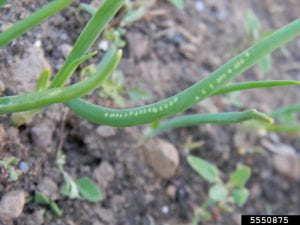
While spring crops are usually not as hard hit as fall crops, this pest has been steadily increasing its geographical range each year and its damage potential. Fields that had pressure last year should be scouted for feeding damage this year. Yellow sticky cards or yellow plastic bowls containing soapy water can be used for monitoring this pest. You can reduce infestation rates by rotating fields, growing leeks as far as possible from chives, and delaying the planting of spring allium crops. Growing allium crops on reflective mulch has reduced the severity of allium leafminer damage in research trials in New York. Placing row covers over allium crops during the period flies and keeping plants covered during the 3-4 weeks of emergence will exclude the pest. Larvae and pupa tend to be found in the outermost layers of leaves from leek and scallion, so the hand removal of these layer will often create a blemish-free product.
Several systemic and contact insecticides are approved for this pest, but EPA registrations vary among Allium crops. When using chemical control, check labels to ensure the crop is listed and for rates and days-to-harvest intervals. Always read and follow the label. The label is the Law.
For chemical recommendations, see the 2020-2021 Mid-Atlantic Commercial Vegetable Production Recommendation Guide: https://extension.umd.edu/mdvegetables/2020-2021-mid-atlantic-commercial-vegetable-production/commodity-recommendations
Azadirachtin (Aza-Direct or other formulations) or spinosad (Entrust or other formulations) are options for organic chemical control.
Thrips in Greenhouse and High Tunnels.
By Jerry Brust, IPM Vegetable Specialist, University of Maryland; jbrust@umd.edu
and Karen Rane, Plant Diagnostician, University of Maryland rane@umd.edu
Over the past few weeks we have seen several greenhouse (GH) and high tunnel (HT) vegetable (basil and tomato mostly, but also lettuce, pepper and spinach) operations from around Maryland having problems with thrips. There are several species of vegetable thrips with the most common being the Eastern flower thrips, Frankliniella tritici, Tobacco thrips Frankliniella fusca, Western flower thrips, F. occidentalis and Onion thrips Thrips tabaci.
The last three species are the ones most likely to transmit tomato spotted wilt virus (TSWV). Thrips are tiny, thin yellowish-orange insects the size of metal filings with fringed wings. Thrips have several generations (up to eight) a year. When the weather is warm, the life cycle may be as short as 2 weeks. They feed by puncturing the outer layer of plant tissue and sucking out the cell contents, which results in stippling or discolored flecking that is usually accompanied by black flecks of frass on the damaged areas of the leaf surface.
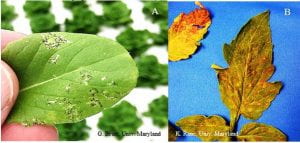
Thrips feeding damage to basil (A) with flecks of black feces associated with feeding scars (B).
Pepper plant with thrips feeding (A) and TSWV symptoms (B).
Sanitation is one of the most important things that can be done to reduce or eliminate thrips and mite problems from a GH or HT before planting. In most of the cases where we found thrips problems, growers did not follow good sanitation practices. They allowed weeds such as prickly lettuce, chickweed, spiny amaranth, lambsquarters, black nightshade and shepherd’s purse to overwinter in their GH or HT. These weed species not only act as hosts for thrips they also can act as hosts for TSWV. In addition to weeds some growers kept bedding plants in their greenhouse before and at the same time as their vegetable transplants, bedding plants are notorious for harboring thrips. This allows thrips to overwinter and get a head start on the new plantings. Never grow vegetable transplants in the same greenhouse with bedding plants.
Lettuce leaf with thrips feeding (A) notice how the black flecks follow the feeding scars on the leaf and TSWV symptoms on tomato leaves (B).
Besides the physical damage to leaf and plant tissue several of the thrips can transmit TSWV (Western flower thrips are good at it while Onion thrips and Tobacco thrips are not quite as good at it and Eastern flower thrips cannot transmit the virus). Tomato spotted wilt virus is an obligate parasite, e.g., it must have a living host and must be moved from one plant to another by thrips or through cuttings or possibly seed. This disease can affect tomato and other Solanaceae crops as well as lettuce, beans, cucumber and 170 other plant species. TSWV may occur in the field but tends to affect greenhouse and high tunnel crops more severely. It may take 2 – 4 weeks from when adult thrips first fed on a plant to see initial symptoms occur. Because of this TSWV appears to spread and worsen in plantings over time. TSWV infected leaves may show deformities and mottling or reddish-brown spots or streaks on leaves or stems. Growing tips are usually affected with systemic necrosis and potentially stunted growth.
We tested for both impatiens necrotic spot virus (INSV) and TSWV on tomatoes and bedding plants. Only TSWV was found in both, no INSV was found in any sample. A few growers had some TSWV resistant (or tolerant) tomato varieties (BHN 444 and 640, Dixie Red and Primo Red) and those plants showed no symptoms. However, research shows that the flowers of resistant plants may NOT be resistant, so plants could possibly still become infected with TSWV if thrips feed on the flowers. Several high tunnel vegetable growing operations as well as some GH operations we have seen or that have been reported to us have 20-30% of their plants showing signs of TSWV infection. These plants will not produce much of anything in the way of a harvest and will need to be removed and replaced.
Growers can monitor for thrips using yellow sticky cards that are placed at the same height as the vegetable plants and checking them 2-3 times a week. Early detection can mean using horticultural oils or biological controls for thrips management rather than relying on synthetic chemicals. The biological control agents work best in greenhouse situations and have had mixed results in high tunnel conditions. Predatory mites such as Amblyseius cucumeris or A. swirskii are two good thrips predators. A swirskii works better in warmer temperatures (77-85o F) while A. cucumeris is better in cooler temperatures. A. cucumeris feeds only on first instar larvae so must be released early before thrips populations increase. Orius insidiosus the insidious flower bug, is best used on crops that are producing pollen or by releasing the bugs onto flowering ornamental pepper plants that are in flower which serve as banker plants. Beauveria bassiana, an entomopathogenic fungus that attacks thrips can control thrips problems before they get started by applying weekly applications very early on in the crop cycle in the GH or HT. However, once thrips populations start to rapidly increase a recommended chemical for GH or HT use on the particular vegetable crop should be used. Be sure you know how your state regulates pesticide use in greenhouses and high tunnels. It should be noted that transmission of TSWV may have already taken place by the time even an effective pesticide is used if TSWV infected weeds or plants are present. The 2020-2021 Mid-Atlantic Commercial Vegetable Production Recommendation Guide has recommendations for both GH and HT management of thrips that might vector TSWV.

